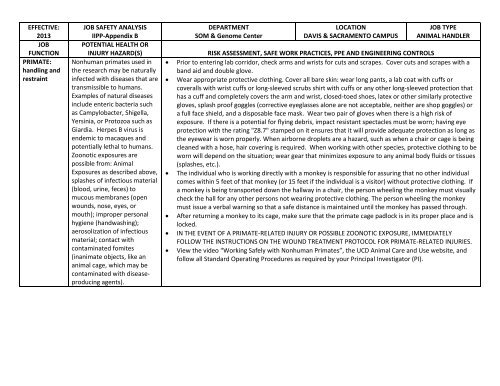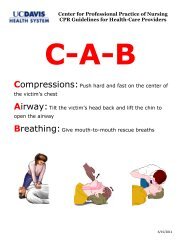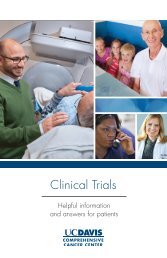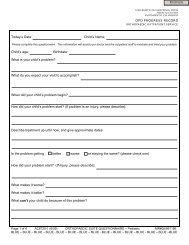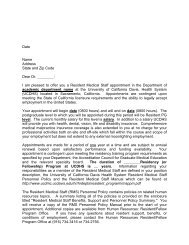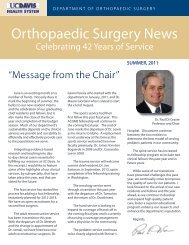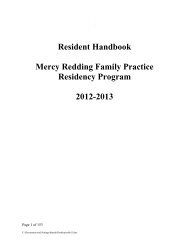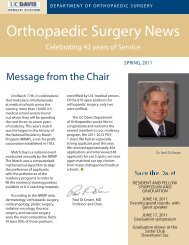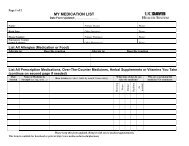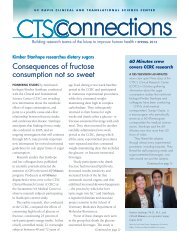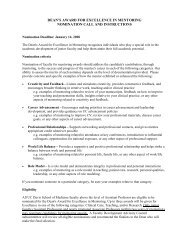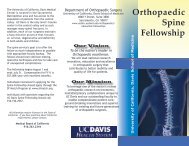JSA – Animal Handler - UC Davis Health System
JSA – Animal Handler - UC Davis Health System
JSA – Animal Handler - UC Davis Health System
Create successful ePaper yourself
Turn your PDF publications into a flip-book with our unique Google optimized e-Paper software.
EFFECTIVE:2013JOBFUNCTIONPRIMATE:handling andrestraintJOB SAFETY ANALYSISIIPP-Appendix BPOTENTIAL HEALTH ORINJURY HAZARD(S)Nonhuman primates used inthe research may be naturallyinfected with diseases that aretransmissible to humans.Examples of natural diseasesinclude enteric bacteria suchas Campylobacter, Shigella,Yersinia, or Protozoa such asGiardia. Herpes B virus isendemic to macaques andpotentially lethal to humans.Zoonotic exposures arepossible from: <strong>Animal</strong>Exposures as described above,splashes of infectious material(blood, urine, feces) tomucous membranes (openwounds, nose, eyes, ormouth); improper personalhygiene (handwashing);aerosolization of infectiousmaterial; contact withcontaminated fomites(inanimate objects, like ananimal cage, which may becontaminated with diseaseproducingagents).DEPARTMENTSOM & Genome CenterLOCATIONDAVIS & SACRAMENTO CAMPUSJOB TYPEANIMAL HANDLERRISK ASSESSMENT, SAFE WORK PRACTICES, PPE AND ENGINEERING CONTROLSPrior to entering lab corridor, check arms and wrists for cuts and scrapes. Cover cuts and scrapes with aband aid and double glove.Wear appropriate protective clothing. Cover all bare skin: wear long pants, a lab coat with cuffs orcoveralls with wrist cuffs or long-sleeved scrubs shirt with cuffs or any other long-sleeved protection thathas a cuff and completely covers the arm and wrist, closed-toed shoes, latex or other similarly protectivegloves, splash proof goggles (corrective eyeglasses alone are not acceptable, neither are shop goggles) ora full face shield, and a disposable face mask. Wear two pair of gloves when there is a high risk ofexposure. If there is a potential for flying debris, impact resistant spectacles must be worn; having eyeprotection with the rating "Z8.7" stamped on it ensures that it will provide adequate protection as long asthe eyewear is worn properly. When airborne droplets are a hazard, such as when a chair or cage is beingcleaned with a hose, hair covering is required. When working with other species, protective clothing to beworn will depend on the situation; wear gear that minimizes exposure to any animal body fluids or tissues(splashes, etc.).The individual who is working directly with a monkey is responsible for assuring that no other individualcomes within 5 feet of that monkey (or 15 feet if the individual is a visitor) without protective clothing. Ifa monkey is being transported down the hallway in a chair, the person wheeling the monkey must visuallycheck the hall for any other persons not wearing protective clothing. The person wheeling the monkeymust issue a verbal warning so that a safe distance is maintained until the monkey has passed through.After returning a monkey to its cage, make sure that the primate cage padlock is in its proper place and islocked.IN THE EVENT OF A PRIMATE-RELATED INJURY OR POSSIBLE ZOONOTIC EXPOSURE, IMMEDIATELYFOLLOW THE INSTR<strong>UC</strong>TIONS ON THE WOUND TREATMENT PROTOCOL FOR PRIMATE-RELATED INJURIES.View the video “Working Safely with Nonhuman Primates”, the <strong>UC</strong>D <strong>Animal</strong> Care and Use website, andfollow all Standard Operating Procedures as required by your Principal Investigator (PI).


